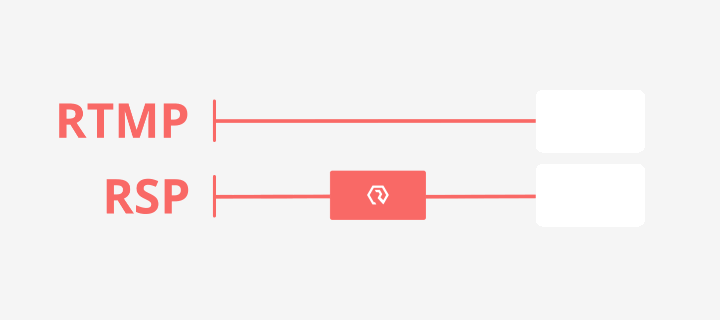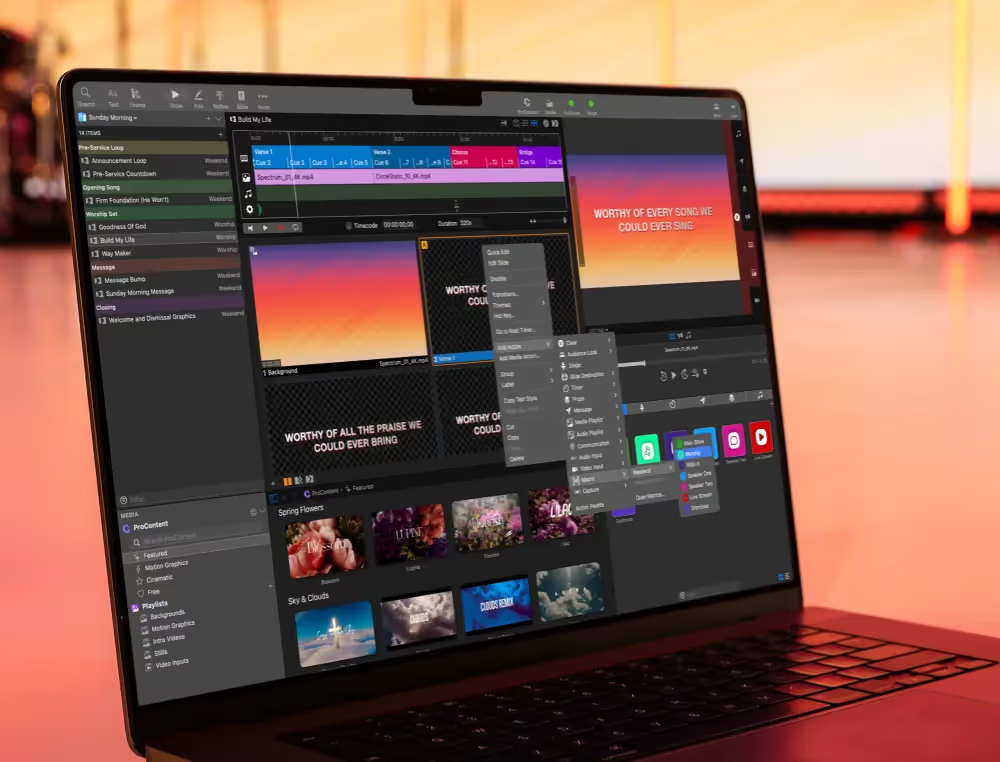Learn more Introducing the ProPresenter Lyric Banner!
From at-home streaming to classrooms to eSports arenas to houses of worship, live streaming is more prevalent than ever before.
As more organizations and individuals get into live streaming, many search for the best encoding and streaming tools for their streaming efforts.
The same applies to those looking to make their existing live stream even more professional and polished.
One core question for anyone live streaming is how to handle video encoding.
To answer this crucial question, we’ve put together this guide to walk you through the options — and show you why ProPresenter is the best solution for most streamers.
Let’s start by answering a couple of questions about encoder software and hardware versus software encoding.
What is Live Streaming Encoder Software, and Why Does it Matter?
Live streaming encoder software is a tool used to convert raw video data from a source (like a camera or a computer screen) into a digital format that can be broadcast over the Internet.
This software is critical in streaming events online, such as sports, conferences, or video game streams. It allows video content to be captured, compressed, and converted into a real-time data stream transmitted to viewers’ devices.
There are two types of encoders: hardware encoders and software encoders. Hardware encoders are physical devices designed to handle the encoding process, while software encoders are programs installed on a computer to do the same job.
Why does live streaming encoder software matter?
- Video Quality: The right encoding software can help ensure your live stream has high quality. It does this by efficiently compressing the video data, so it can be transmitted over the Internet without losing too much quality. The better the encoder, the better the file size and video quality balance.
- Speed and Performance: Encoder software helps ensure that your live stream is sent over the Internet in real time or with minimal delay. Different encoders may vary in efficiency, and the right one can help minimize lag or buffering during the stream.
- Compatibility: The streaming encoder software ensures that the live stream is in a format that can be received and decoded by various devices, including computers, tablets, and smartphones. For instance, the H.264 codec is widely used because of its compatibility with various devices.
- Bandwidth Management: Encoder software allows control over the stream’s bitrate, which is crucial when considering the viewer’s internet speed capabilities. Higher bitrate means better quality but requires more bandwidth, which some viewers may not have. Thus, an adjustable bitrate makes the stream available to a wider audience.
- Features: Many encoder software offers additional features like adding overlays, mixing audio, multi-camera streaming, etc., that can enhance the viewer’s experience.
Hardware vs. Software Encoding
Whether you’re new to the world of streaming or you’ve been at it a while, here’s a quick refresher on the available options for video encoding.
There are two options: hardware encoders and software encoders.
Both approaches have pros and cons, and whether you should choose encoder software or hardware-based approaches depends on numerous factors.
Why do you need encoding in the first place?
Bandwidth.
A regular 1920×1080 video at 60 frames per second takes about 3 gigabits per second.
That’s 3,000 megabits per second; however, a YouTube video is around 5 Mbps.
Encoding takes that 3,000 Mbps and, using some smart techniques, crunches the video size to something manageable while still making sure it looks good to the end user.
Whether using hardware or software, these do the same thing: take a full-size video, and crunch it down.

Hardware Encoders
Hardware encoders are standalone devices built for streaming. Video comes in, they encode it, and send the stream right to the Internet.
The Blackmagic Design Web Presenter, Teradek Vidiu, AJA Helo, and Resi Ray are some examples.
It’s also becoming more common for hardware encoders to be built into other video gear, like Blackmagic’s ATEM Mini Pro video switcher.
These are still considered hardware-based since they don’t require your PC to handle the encoding.
Encoder Software & Software Switchers
Software encoders run on a computer, relying on the computer’s processing to encode the signal. There’s generally a capture card or capture device to pull the video signal into the system, then it’s processed by software.
Most software encoders are built into a software switcher which allows you to layer on content like graphics, text, and video and switch between different scenes or video inputs.
Examples are Open Broadcaster Software (OBS), Vmix, Wirecast, Livestream Studio 6, and ProPresenter.
Software encoders are desirable for many live streamers to reduce the complexity of streaming setup, and to support lower thirds or overlays without needing a hardware switcher.
A hardware encoder’s added cost and complexity aren’t worth the trouble for basic live streaming.
Software encoders combined with software switchers as an all-in-one solution are also more flexible with adding graphics, creating graphics on the fly, and layering them on the go as needed.
That said, software encoders come with their own drawbacks.
You’ll need a powerful computer to run the encoding software without issues.
That means a strong GPU, CPU, and a reasonable amount of RAM.
Low-end systems without a dedicated GPU will sometimes advertise “AMD Integrated Graphics” or “Intel UHD Graphics”.
These are unfit for encoding and will give you headaches, even on the lowest settings.
Software Encoders on the Market Today
If you’ve settled on software encoding instead of hardware encoding for your streaming setup, you’ll find numerous choices on the market.
These are the most prevalent software solutions, plus a little information and context for each.

OBS Studio
Open Broadcaster Software is the most widely used software encoder, operating on Mac, Windows, and Linux.
It’s free, does a good job, and has many features, making it attractive to people new to streaming. OBS uses the limited RTMP streaming protocol (more on this below).
Most people use the regular OBS Studio. However, several variations, like Streamlabs OBS and OBS.live, take the core OBS framework and build some external options onto it.
Because OBS is free and open-source, official support is lacking and can be frustrating when needing to get real solutions to problems or features built out.

vMix
vMix is a leading paid option, with tiered features and packages at various price points from $60 to $1200.
The feature set is deep, though some of the most attractive features (like instant replay, multiple outputs, and 4K video) are reserved for the higher tiers. vMix makes use of the limited RTMP streaming protocol.
vMix includes support for animated titles, tickers, and other on-screen display content. Notably, vMix is a PC-only product, with no Mac options.
View our ProPresenter vs. vMix comparison guide here.

Livestream Studio 6
A part of the Vimeo family, Livestream’s Studio 6 is a high-end software encoder designed for professional production environments, with plans starting at $75 per month.
It has advanced color correction options, PTZ control for certain cameras, and supports live ad insertion for large-scale productions. Live Stream Studio 6 makes use of the limited RTMP streaming protocol.
Livestream Studio 6 is a good product and worth looking at for high-end software solutions.

ProPresenter
ProPresenter runs on both Mac and Windows and is an all-in-one production app for editing graphics, presenting content to local screen outputs, switching between video inputs and cameras, and live streaming online.
ProPresenter is the only streaming software to include Resi’s Resilient Streaming Protocol, RSP, which allows for high-quality, uninterruptible streams even over choppy internet connections.
More on this below, under Streaming Protocols. ProPresenter also offers industry-standard RTMP for users with quality internet connection allowing the option to live stream for free.
Businesses and organizations already using ProPresenter for presentations have no need to purchase a second software tool for live streaming; ProPresenter does it all in one package.

Streaming Protocols: Is RTMP Best?
RTMP/RTMPS has become the most common protocol for streaming. It uses fire-and-forget to send video packets over the internet, so there’s no error correction if a packet is lost.
This means it’s a simple technology but can become jumpy if your internet connection becomes choppy.
The Resilient Streaming Protocol (RSP) is an updated approach to streaming.
Resi created a custom protocol for smooth playback by adding additional measures so packets aren’t dropped and a two-minute buffer in case of major catastrophe.
You can physically cut your Internet cable, and if the connection is restored within two minutes, the end user won’t notice a thing in the live video.
With RTMP, a dropped connection for 2 minutes will usually mean your video platform decides the stream is finished and end it completely.
Because of RSP you can have a bulletproof stream with no choppiness, lag, or drops in framerate, which can be connected from Resi to social networks or embedded on a website using their own player.

As mentioned, ProPresenter is the only software that uses RSP, and the only software capable of the most reliable streaming solution that exists.
If you’re looking for the best solution for encoding a high-quality, reliable stream, Resi is the best, and that’s why we recommend ProPresenter as the best software encoder.
ProPresenter: The Best Software Encoder for Live Streaming
Thanks to the inclusion of Resi’s RSP, ProPresenter is the best video encoder for live streaming for most businesses, individuals, and organizations.
Here are just a couple of examples of common uses for streaming with ProPresenter:
- Churches that already have ProPresenter for live presentation needs, can easily add live streaming without needing additional devices or hardware.
- Live events and eSports organizations that want the resilient streaming and real-time content display combined with flashy lower thirds.
- Corporate events that need to be bulletproof even under difficult network conditions or in remote locations with limited network connectivity.

Ready to see how ProPresenter can transform your live video encoding efforts? Start your two-week unlimited trial today!
By subscribing, you agree to our Terms and Conditions.
Experience the power of ProPresenter
Take your production to the next level with ProPresenter's intuitive suite of tools.

Stay Updated with Our Newsletter
Get the latest news, updates, and exclusive offers delivered straight to your inbox.

Questions?
Browse our FAQs or our Knowledge base that we’ve made to answer your questions. Need additional help? Connect with a support team agent!


.png)
.avif)